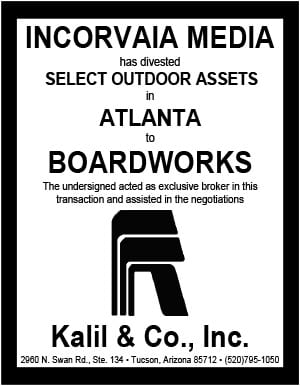
By Michael F Wright
Ever since Metromedia, Inc. v. City of San Diego (1981), courts have been applying an ultra-lenient version of intermediate scrutiny under Central Hudson Gas & Electric Co. v. Public Service Commission (1980) to content-based regulation of commercial signs. Then in Reed v. Town of Gilbert, Arizona (2015), the Supreme Court held that content-based sign regulations are subject to strict scrutiny. Concerned that Reed would overrule Central Hudson, courts have limited Reed to noncommercial signs. These courts misinterpret Reed and Central Hudson. Although Reed involved noncommercial speech, the Court relied on commercial speech cases for points essential to its holding. The Court wouldn’t have done that unless it intended its decision to apply to commercial as well as noncommercial speech.
Applying the strict scrutiny test of Reed does not overrule Central Hudson. The Court has repeatedly said that government’s interest in preventing “commercial harms,” such as fraud and overreaching, entitles certain regulations of commercial content to more lenient scrutiny. Central Hudson is not a universal test but an exception to the usual rule of strict scrutiny; intermediate scrutiny under Central Hudson is applicable only where government regulates to prevent commercial harms. The typical sign ordinance is designed to promote entirely different interests, i.e. safety and aesthetics. Such ordinances are outside the scope of Central Hudson and should be subject to strict scrutiny under Reed.
In Reed, the Supreme Court held that a sign ordinance that distinguished among political, ideological and temporary directional signs violated the First Amendment. The Court reasoned that a speech regulation is “content based if [it] applies because of the topic discussed or the idea or message expressed.” In deciding whether a regulation is content-based a court must first consider whether “on its face” the regulation “draws distinctions based on the message a speaker conveys.” If it does, the regulation is subject to strict scrutiny, “regardless of the government’s benign motive, content-neutral justification, or lack of ‘animus toward the ideas contained’ in the regulated speech.”
Although Reed dealt with noncommercial content, as one commentator observes, “Almost by definition, ordinances regulating commercial speech will distinguish speech facially based on its content.” A straightforward reading of Reed would subject these ordinances to strict scrutiny.
Courts and academicians recoiled from the idea that Reed applies to commercial signs. They reasoned that applying Reed to commercial speech would overrule Central Hudson and the “commercial speech doctrine,” i.e. the principle that noncommercial speech occupies a higher place than commercial speech in a First Amendment hierarchy.
This analysis, while widely accepted, views Reed too narrowly and Central Hudson too broadly. The argument that Reed is limited to noncommercial speech ignores the Court’s reliance on commercial speech cases for points essential to its holding. Reed cited Sorrell v. IMS Health, Inc. (2011), a commercial speech case, as authority for its definition of content-based regulations. This citation, observes one commentator, suggests that the definition “applies broadly to commercial speech cases.” The Court cited Sorrell again as authority that courts must first look to the face of a statute to determine whether it is content based. It cited another commercial speech case, Cincinnati v. Discovery Network, Inc. (1993), twice for the proposition that a facially content-based law is “subject to strict scrutiny” regardless of the government’s motive or intent.
The courts that have limited Reed to noncommercial content ignore the fact that the Court based much of its rationale on commercial speech cases. But the Supreme Court cites cases for a reason. As commentators have noted, the Court’s citations to precedent, mostly its own prior opinions, “form the fundamental justification” for its decisions. Reliance on prior cases represents a judgment by the Justices that the cases they cite are like the one they are deciding. The Court’s reliance on commercial speech cases thus is a clear signal that Reed applies to commercial as well as noncommercial speech.
But if so, does Reed overrule Central Hudson and the commercial speech doctrine? Not if courts take seriously the limitations on the doctrine the Supreme Court has repeated in several decisions. In Discovery Network, in the plurality opinion in 44 Liquormart, Inc. v. Rhode Island (1996), in Sorrell, and again in Matal v. Tam (2017), the Court recognized that “government’s legitimate interest in protecting consumers from commercial harms explains why commercial speech can be subject to greater governmental regulation than noncommercial speech.” This interest explains why securities disclosure requirements, active-ingredients disclosures on medicine labels, and laws prohibiting false advertising are not subject to strict scrutiny. False or incomplete commercial information can lead investors and consumers to make decisions that harm them financially and physically. Only commercial speech poses those risks. Noncommercial speech may lead you to vote for the wrong candidate, but it won’t cause you to invest with Bernie Madoff or buy a bottle of snake oil. Government’s interest in preventing commercial harms thus defines the scope of Central Hudson and the commercial speech doctrine.
Sign regulations are different. They are designed to promote safety and aesthetics. As the California Supreme Court said in Metromedia, Inc. v. City of San Diego (1982) “the commercial or noncommercial character of the billboard’s message is largely irrelevant to these goals.” Similarly, in Discovery Network the Court held that the commercial newsracks a city ordinance banned were “no greater an eyesore” than the noncommercial newsracks the city permitted on its streets. Discovery Network further recognized that outside the context of commercial-harms regulation, “it would seem to follow” that strict scrutiny applies to content-based regulations of commercial speech. As one commentator writes, Discovery Network implies that “commercial speech must be targeted for the reasons it is entitled to less constitutional protection, not simply because it is less protected.”
Where government regulates speech to prevent commercial harms, Central Hudson applies to restrictions that target commercial content. But where it regulates to promote safety and aesthetics, as in the case of the typical sign ordinance, the reason for more lenient scrutiny is absent and Reed’s rule of strict scrutiny applies.
You can reach Michael F Wright at mfwrightlaw@gmail.com, 213-236-1681.
[wpforms id=”9787″]
Paid Advertisement

















